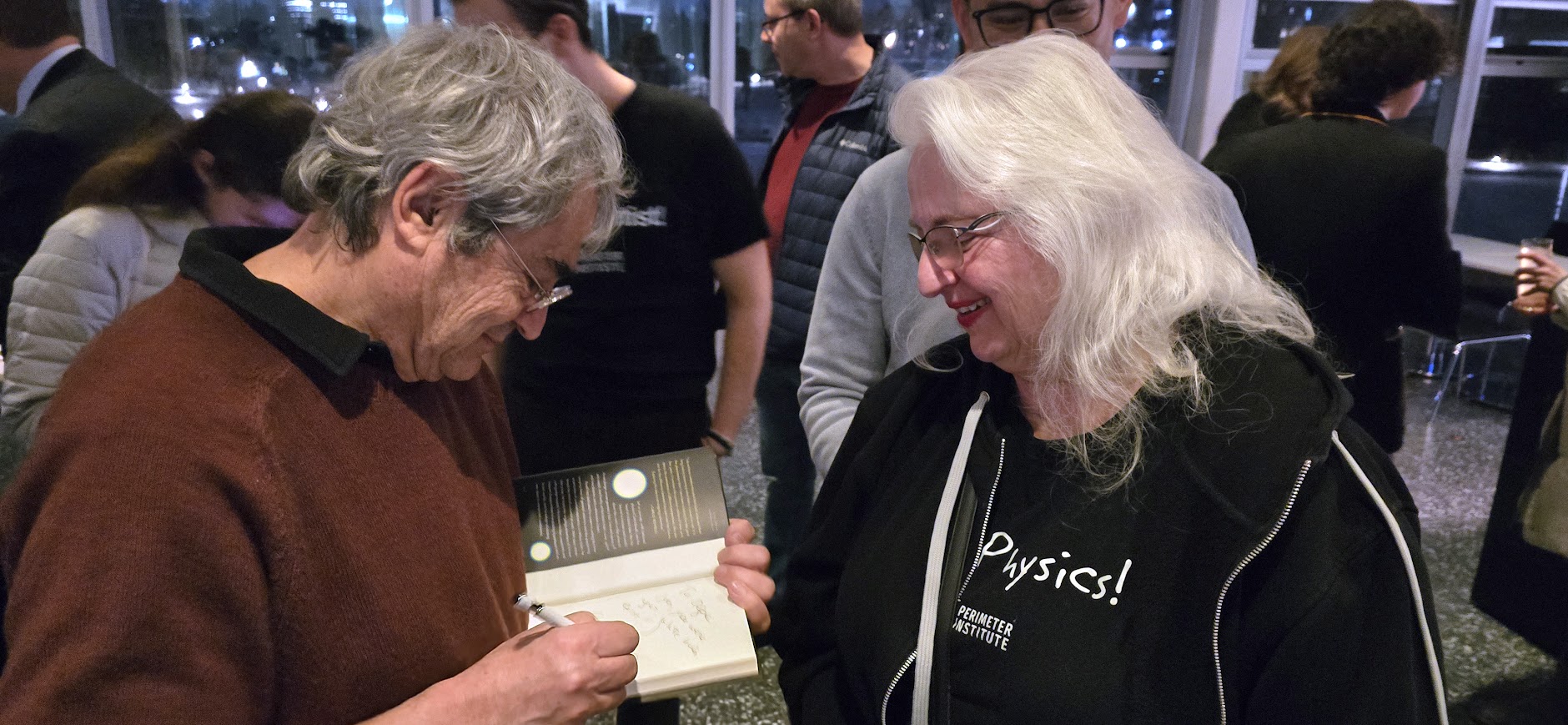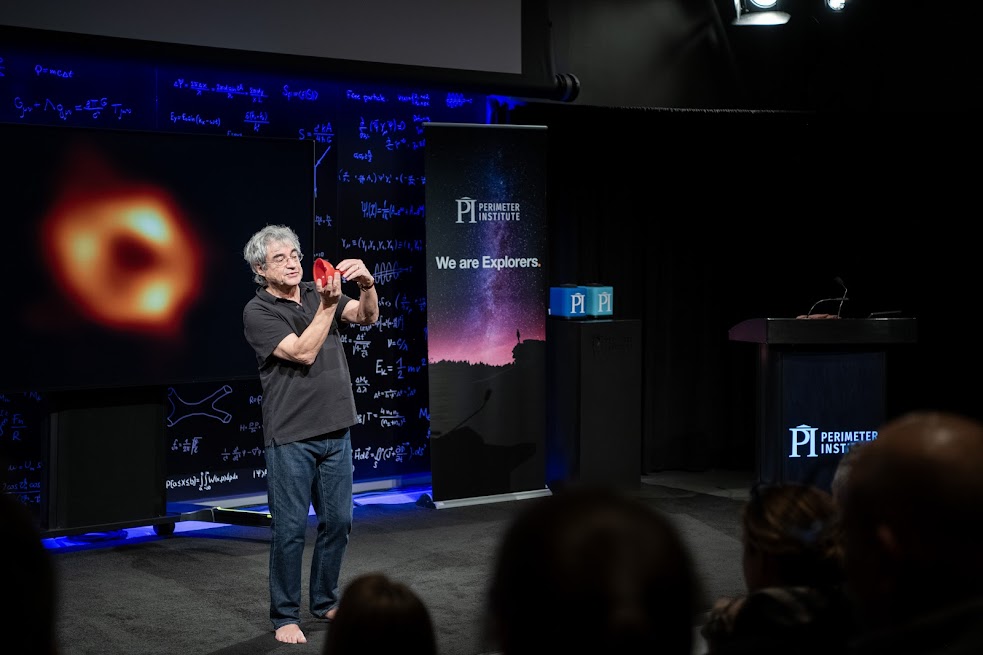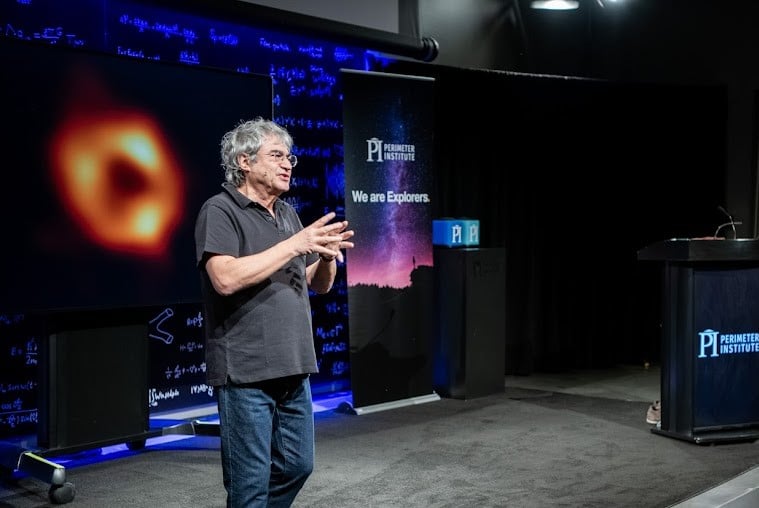If we could travel through space and time, to the year 1609 and to the grounds of the University of Padua, Italy, we might find Galileo with his new and improved telescope, drawing back the dark curtain that shrouded humankind’s knowledge of the universe.
He saw moons of Jupiter, the phases of Venus, dark spots across the Sun, and countless stars of the Milky Way galaxy. In doing so, he revolutionized our understanding of the universe, and our place in it.
Hundreds of years later, Carlo Rovelli was born, just a few kilometres from Padua. Today, he is drawing that curtain back further, using loop quantum gravity, a field of theoretical physics that he and his colleagues (including Perimeter’s Lee Smolin) founded, describing our cosmos in terms of networks of spacetime building blocks.
“Galileo had this fabulous moment of clarity,” Rovelli said in a recent interview. “He had the idea of carefully exploring the stars with a newly invented telescope. He was a great, careful observer, and was amazed at what he saw.”
Science and technology have advanced tremendously in more than 400 years since the days of Galileo. Today, we have fantastic instruments such as the Event Horizon Telescope that has given us images of supermassive black holes. Just like Galileo, “we are looking out, discovering new facts about the Universe and in doing so also getting a better understanding and clarity about ourselves,” Rovelli says.
Rovelli is a prolific communicator of great science ideas for the general public. His popular books include Seven Brief Lessons on Physics; The Order of Time; Reality Is Not What It Seems: The Journey to Quantum Gravity; Helgoland: Making Sense of the Quantum Revolution; and his most recent book, White Holes.
He is also a Distinguished Visiting Research Chair at Perimeter Institute, adjunct professor at Western University, fractal faculty at the Santa Fe Institute for Complexity and professor at Aix-Marseille University, France.
Rovelli’s main current interest is in exploring the inner workings of black holes. In a recent public lecture at Perimeter, Rovelli described a journey into a black hole’s event horizon, across its singularity, and explained how anything that fell inside might, after a very long time, come out again.
Rovelli is exploring the hypothesis that black holes could transition into tiny ‘white holes,’ from which it is possible for particles to escape. Tiny white holes generated by primordial black holes are also candidates for dark matter – a mysterious entity that is needed to explain the gravitational interactions seen in galaxies and galaxy clusters.
“People are fascinated by black holes, but I would say scientists are fascinated by black holes even more; they are truly marvels of the universe,”
“One of the most surprising discoveries of the last 20 years is that the universe is full of these black holes, which are very strange objects indeed,” he adds.
The possibility of the existence of black holes is predicted by Albert Einstein’s gravity theory, the theory of general relativity. The equations describe how spacetime bends and sags in response to heavy masses, generating the effect that we know of as gravity.
Einstein’s equations show that a star can collapse to the point where the gravity is so strong that nothing, not even light, can escape its boundary, known as its event horizon. That is a black hole.
For many years after Einstein, black holes were only hypothetical. Now we have many observations to prove that they exist. We can see the dark faces of black holes surrounded by characteristic rings, which are optical distortions, caused by the hole, of the light emitted by gas and dust surrounding it. We can track the orbits of stars around a black hole.
But the fascinating questions are: What happens if you fall into one? What lies within the dark heart of a black hole? This is where science depends on people like Rovelli, a theoretician. His job is to work out what might happen.
If you fell into a stellar mass black hole that is, say, 50 times the mass of the Sun, the tidal forces would of course quickly tear you apart. You would become stretched and spaghettified. If you fell into a huge supermassive black hole, billions of times the mass of the Sun, like those at the centres of galaxies, the tidal forces would not be as strong, at the beginning. You might survive for a time, but eventually you would be squeezed and you would not emerge intact.
Inside the black hole
The most interesting aspect of Einstein’s theory is that space and time are distorted by mass. Time lapses at different paces for different observers, depending on whether they are the person falling into the black hole, or the observer watching from the outside.
For the person falling into the event horizon, his watch will look normal. But for someone in a spaceship far from the black hole, the colleague will appear slowing down and ultimately frozen, as if time has slowed to a stop. Eventually, as the light of the image that is reflected is stretched, the image will fade away.
Einstein theory tells us what happens to matter that falls into the black hole, but only to a point. Falling matter reaches a region where space is so strongly curved that Einstein’s theory is not valid anymore, and quantum effects take over.
A celebrated result obtained by the late Stephen Hawking is that black holes emit radiation, and their horizons will shrink. But while the horizon shrinks, the same may not be true of their interior. The interior volume can grow even if the area of the horizon surrounding it becomes smaller, Rovelli explains. As time passes, the interior of the hole is like a tube becoming longer but narrower. Imagine a glass blower blowing the neck of a bottle so that the neck gets longer and longer. The volume of the tube can grow even if the throat becomes smaller. It would be much like Doctor Who’s Tardis – bigger on the inside than the outside.
As the cosmic glassblower continues to make the neck longer and longer, but narrower and narrower, everything becomes so compressed, quantum effects become increasingly more important and take over. This is where the theory of loop quantum gravity comes in. According to loop quantum gravity, what happens next can be a bounce: the black hole becomes a white hole.
Why have we not seen white holes?
The possibility of the existence of white holes is also predicted by Einstein’s theory. So far, we have not observed any white holes, but this does not mean that they do not exist. For a long time, no black hole was observed either, Rovelli says.
Large black holes like the ones we see in images from the Event Horizon Telescope, would not have had the time to mutate into white holes yet, he explains. On the other hand, tiny black holes might have formed in the primordial universe, and these might have mutated into white holes, because for tiny black holes, the transition to white holes would happen more rapidly.
Furthermore, large white holes are unstable: they can fall back into being black holes. But tiny white holes, says Rovelli, can be stabilized by quantum gravity.
Tiny white holes might explain dark matter
Rovelli suggests that it is possible that these tiny white holes could explain the mysterious dark matter.
Dark matter is needed to explain the gravitational interactions that we can detect in galaxies and galaxy clusters. In fact, based on the calculations for the amount of matter needed to explain these interactions, it is thought that about four fifths of the matter filling the universe is made of this ‘dark’ matter, although we don’t know what it is made of.
Rovelli says it is possible that dark matter could be those tiny white holes that formed in the early universe but are not perceptible to us because they have such low mass.
He and his collaborators have recently published a paper with ideas for building a detector with advanced quantum technology that would be sensitive enough to detect these tiny white holes. If they are found, they would help validate both loop quantum gravity and be a dark matter explanation.
“We hope that experimentalists will pick up the idea, start developing this detector and work toward this,” Rovelli says.
Everything is relationships
A core aspect of Rovelli’s work is the relational interpretation of quantum mechanics. This interpretation describes quantum phenomena as a consequence of the fact that all properties of any objects are only ways these objects interact with other objects. Loop quantum gravity is consistent with this interpretation of quantum theory. Spacetime can be thought as formed by networks of spacetime building blocks in relation to one another.
Rovelli has also long worked on a number of different problems raised in trying to understand the nature of time.
The basic equations of both classical and quantum physics do not distinguish between backward and forward time. But this does not mean that time does not have a direction in nature: it only means that this direction is not in the basic equations, Rovelli says.
He thinks the direction of time is an effect of the way entropy changes, as described by second law of thermodynamics. Entropy is determined by intrinsic uncertainty we have about the exact microscopic state of what we observe, Rovelli says.
But this does not mean the direction of time is determined by our minds, its knowledge or ignorance, he adds. “The subtle point is that entropy itself is a relational quantity,” Rovelli says.
Changing our minds, leaving prejudices behind
From the time of his adolescence, Rovelli was interested in philosophical questions. He did not expect to find final or definitive answers in science, but he wanted to study physics to know what it had to say about the world. “To my surprise, it says more than what I expected,” Rovelli says.
“For me, science is not about problem-solving; it is not about technicalities. It is to be thinking about the big questions. What is reality? Where are we?”
Science is humbling, Rovelli adds. “Science doesn’t have all the answers because as humans we can’t have all the answers. We might never know where the universe came from. But that’s OK. We can live with ignorance as long as we are aware of our ignorance. And we can still learn new things.”
Like Galileo with his telescope, we are gradually opening up our minds to new perspectives that we did not conceive of before, Rovelli says. At one time, humans thought the world was flat; two millennia ago, as they looked out, they realized it was round. At one time, humans thought the earth was the centre of the universe; four centuries ago, they looked out and saw a vast cosmos and discovered that we are definitely not at the center. Humans once thought that an hour was always an hour for everyone, no matter where they are, and then, after Einstein’s theories, they realized that isn’t the case.
“We change our minds about people, about space, about time,” Rovelli says. That is what science does, he adds. “It’s not just that we learn new things from science, but that we also realize that what we thought was true was wrong.”
“Some people are attracted by science because they think it offers certainty. I am attracted by science because it demolishes certainty,”
“We are growing out of our stupidity, our narrowness. The more we learn about the universe, the more we come out from our prejudices. At least, that is my optimism,” he says. “Humankind is like a village, and we are coming out of the village and discovering the world.”
Discover more:
As part of our 25th anniversary, Perimeter is hosting a Galileo exhibition this month in partnership with the Italian Embassy and the Galileo Museum in Florence.
About PI
Perimeter Institute is the world’s largest research hub devoted to theoretical physics. The independent Institute was founded in 1999 to foster breakthroughs in the fundamental understanding of our universe, from the smallest particles to the entire cosmos. Research at Perimeter is motivated by the understanding that fundamental science advances human knowledge and catalyzes innovation, and that today’s theoretical physics is tomorrow’s technology. Located in the Region of Waterloo, the not-for-profit Institute is a unique public-private endeavour, including the Governments of Ontario and Canada, that enables cutting-edge research, trains the next generation of scientific pioneers, and shares the power of physics through award-winning educational outreach and public engagement.




